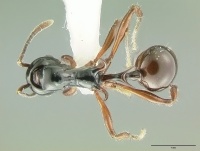Ancyridris rupicapra
| Ancyridris rupicapra | |
|---|---|

| |
| Scientific classification | |
| Kingdom: | Animalia |
| Phylum: | Arthropoda |
| Class: | Insecta |
| Order: | Hymenoptera |
| Family: | Formicidae |
| Subfamily: | Myrmicinae |
| Tribe: | Crematogastrini |
| Genus: | Ancyridris |
| Species: | A. rupicapra |
| Binomial name | |
| Ancyridris rupicapra (Stitz, 1938) | |
This ant is one of two species of Ancyridris. It is known from a single type specimen.
Identification
The hooked end of the long propodeal spines, curved towards the head, and the rearward bending elongate petiole spines are a distinctive feature of both species of this genus. Beyond this the genus is similar to Aphaenogaster or certain worker forms of Pheidole.
Distribution
Distribution based on Regional Taxon Lists
Indo-Australian Region: New Guinea (type locality).
Distribution based on AntMaps
Distribution based on AntWeb specimens
Check data from AntWeb
Countries Occupied
| Number of countries occupied by this species based on AntWiki Regional Taxon Lists. In general, fewer countries occupied indicates a narrower range, while more countries indicates a more widespread species. |

|
Estimated Abundance
| Relative abundance based on number of AntMaps records per species (this species within the purple bar). Fewer records (to the left) indicates a less abundant/encountered species while more records (to the right) indicates more abundant/encountered species. |

|
Biology
Castes
Known only from the worker caste.
Nomenclature
The following information is derived from Barry Bolton's Online Catalogue of the Ants of the World.
- rupicapra. Pheidole (Pheidolacanthinus) rupicapra Stitz, 1938: 99, fig. 1 (w.) NEW GUINEA (Papua New Guinea).
- Type-material: holotype worker.
- Type-locality: Papua New Guinea (“German New Guinea”): (no further data) Kaiserin-Augustafluss-Expd. (Bürgers).
- Type-depository: MNHU.
- Combination in Ancyridris: Bolton, 1995b: 63.
- Status as species: Chapman & Capco, 1951: 138; Bolton, 1995b: 63; Taylor, 2009: 24.
- Distribution: Papua New Guinea.
Unless otherwise noted the text for the remainder of this section is reported from the publication that includes the original description.
Description
References
- Bolton, B. 1995b. A new general catalogue of the ants of the world. Cambridge, Mass.: Harvard University Press, 504 pp. (page 63, Combination in Ancyridris: new combination)
- Stitz, H. 1938. Neue Ameisen aus dem indo-malayischen Gebiet. Sitzungsber. Ges. Naturforsch. Freunde Berl. 1938: 99-122 (page 99, fig. 1 worker described)
References based on Global Ant Biodiversity Informatics
- Janda M., G. D. Alpert, M. L. Borowiec, E. P. Economo, P. Klimes, E. Sarnat, and S. O. Shattuck. 2011. Cheklist of ants described and recorded from New Guinea and associated islands. Available on http://www.newguineants.org/. Accessed on 24th Feb. 2011.
- Stitz H. 1938. Neue Ameisen aus dem indo-malayischen Gebiet. Sitzungsber. Ges. Naturforsch. Freunde Berl. 1938: 99-122.
- Taylor R. W. 2009. Ants of the genus Lordomyrma Emery (1) generic synonymy, composition and distribution, with notes on Ancyridris Wheeler and Cyphoidris Weber (Hymenoptera: Formicidae: Myrmicinae). Zootaxa 1979: 16-28.



